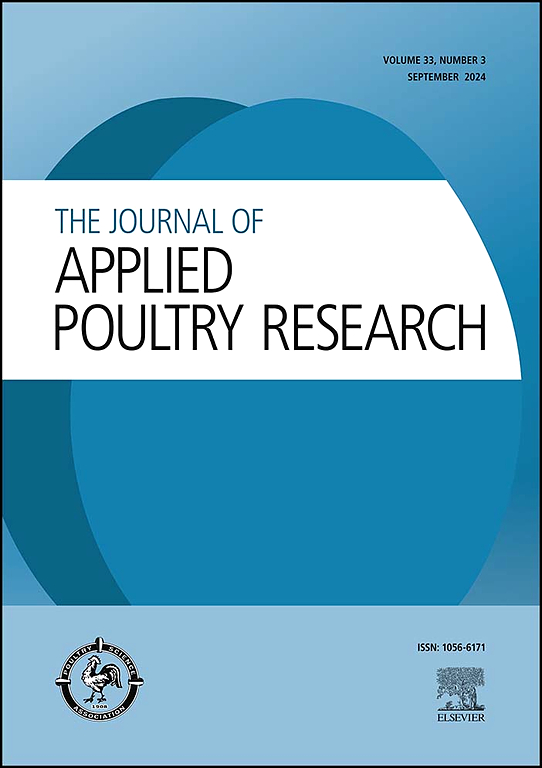Response of broiler chickens vaccinated against coccidiosis to diets containing varying amino acid density and a nucleotide-rich extract during the pre-starter and starter periods
IF 2
3区 农林科学
Q2 AGRICULTURE, DAIRY & ANIMAL SCIENCE
引用次数: 0
Abstract
Growth depression is often associated with coccidial vaccinations used to suppress coccidiosis in broiler chickens. Dietary strategies such as amino acid (AA) modulation have shown promise in mitigating the negative impacts of coccidiosis. Additionally, nucleotide supplementation may support immune and digestive functions in young broilers, potentially enhancing their resilience to infections. The current study investigated the interactive effects of dietary AA density and nucleotide supplementation on growth response and processing yields of broilers vaccinated against coccidiosis. One thousand eight hundred male broiler chicks were assigned to 10 dietary treatments each with 9 replicate pens and 20 birds per pen. Eight dietary treatments contained two levels of AA density; “low” (1.20/1.15 %) or “high” (1.35/1.25 %) digestible Lys during the pre-starter and starter phases, respectively and included nucleotide supplementation in either, both, or neither phase. Two additional diets, containing low or high AA density without nucleotide supplementation were fed to unvaccinated chicks as positive controls. There was no interaction between AA density and nucleotide supplementation on growth or nitrogen digestibility under coccidia challenge. Broilers fed higher AA density had improved weight gain and FCR during the starter period. Nucleotide supplementation enhanced gut health by reducing intestinal lesions in birds receiving high AA diets. Higher AA density improved processing yield at d 41 but was associated with increased incidence of footpad lesions. Overall, our findings suggest that increased AA density supports growth and carcass traits in vaccinated broilers, but strategic use of nucleotide supplementation may help modulate gut health during periods of intestinal stress.
接种球虫病疫苗的肉鸡在发菜前和发菜期对不同氨基酸密度饲粮和富含核苷酸提取物的反应
生长抑制通常与用于抑制肉鸡球虫病的球虫疫苗有关。膳食策略如氨基酸(AA)调节已显示出减轻球虫病负面影响的希望。此外,核苷酸补充可能支持雏鸡的免疫和消化功能,潜在地增强它们对感染的抵抗力。本研究旨在研究饲粮AA密度和核苷酸添加对接种球虫疫苗肉鸡生长反应和加工产量的交互作用。试验选用雄性肉鸡1800只,分为10个饲粮处理,每个处理设9个重复栏,每个栏20只鸡。8个饲粮处理AA密度为2个水平;“低”(1.20/ 1.15%)或“高”(1.35/ 1.25%)消化赖氨酸分别在前发酵期和发酵期,并包括在任何一个阶段,两个阶段或两个阶段补充核苷酸。在未接种疫苗的雏鸡中添加两种不添加核苷酸的AA密度低或高的饲粮作为阳性对照。在球虫胁迫下,氨基酸密度和核苷酸添加量对生长和氮消化率无交互作用。饲喂较高AA密度的肉鸡在发酵期增重和料重比显著提高。在接受高AA日粮的鸟类中,核苷酸的补充通过减少肠道病变来增强肠道健康。较高的AA密度提高了第41天的加工产量,但与脚垫病变发生率增加有关。总的来说,我们的研究结果表明,增加AA密度有助于接种肉鸡的生长和胴体性状,但在肠道应激期间,战略性地使用核苷酸补充可能有助于调节肠道健康。
本文章由计算机程序翻译,如有差异,请以英文原文为准。
求助全文
约1分钟内获得全文
求助全文
来源期刊

Journal of Applied Poultry Research
农林科学-奶制品与动物科学
CiteScore
4.10
自引率
10.50%
发文量
80
审稿时长
104 days
期刊介绍:
The Journal of Applied Poultry Research (JAPR) publishes original research reports, field reports, and reviews on breeding, hatching, health and disease, layer management, meat bird processing and products, meat bird management, microbiology, food safety, nutrition, environment, sanitation, welfare, and economics. As of January 2020, JAPR will become an Open Access journal with no subscription charges, meaning authors who publish here can make their research immediately, permanently, and freely accessible worldwide while retaining copyright to their work. Papers submitted for publication after October 1, 2019 will be published as Open Access papers.
The readers of JAPR are in education, extension, industry, and government, including research, teaching, administration, veterinary medicine, management, production, quality assurance, product development, and technical services. Nutritionists, breeder flock supervisors, production managers, microbiologists, laboratory personnel, food safety and sanitation managers, poultry processing managers, feed manufacturers, and egg producers use JAPR to keep up with current applied poultry research.
 求助内容:
求助内容: 应助结果提醒方式:
应助结果提醒方式:


